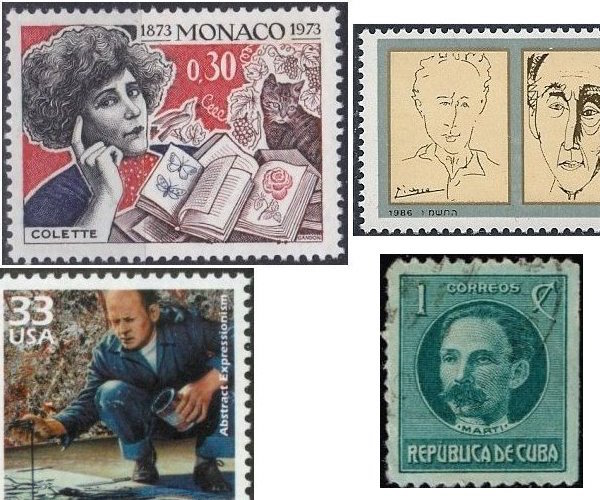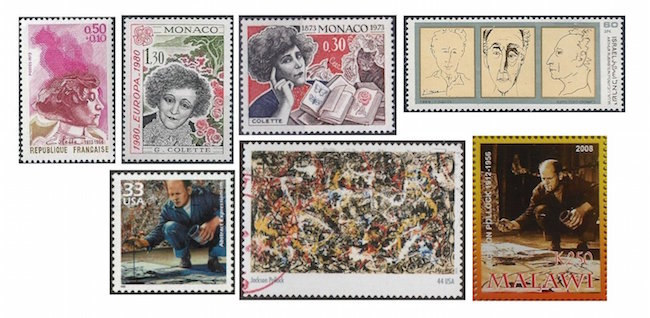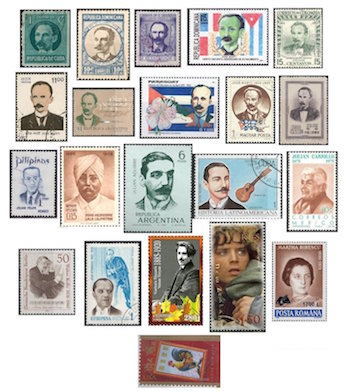The Arts on the Stamps of the World — January 28
An Arts Fuse regular feature: the arts on stamps of the world.

By Doug Briscoe
Another huge birthday bash, our biggest yet, as today we note the birthday of Colette, Arthur Rubinstein, and Jackson Pollock, along with nine (!) other artists (writers/poets—three of them fighters for their countries’ independence—composers, and a tenor) and Elijah Wood. Fear not, I will hold your hand while we stride boldly forth on this epic journey.
Colette (born Sidonie-Gabrielle Colette, 28 January 1873) not only wrote a shelfload of novels (she was nominated for the Nobel Prize in 1948), but also penned the libretto for Ravel’s one-act opera L’Enfant et les Sortilèges. She died on 3 August 1954 and was the first French woman of letters to be given a state funeral.
Artur Rubinstein (1887 – December 20, 1982) was born in Łódź and was recognized as a child prodigy at the age of four. He made his Carnegie Hall debut in 1906. He spoke eight languages and had a phenomenal memory. His long career came to an end with his retirement in 1976 at age 89. Rubinstein is beloved as one of the greatest pianists of the twentieth century and perhaps the greatest Chopin interpreter of his time. He died in his sleep at his home in Geneva, Switzerland at the age of 95. I warmly recommend his delightful autobiographical volumes My Young Years and My Many Years. His only stamp was issued by Israel in 1986.
Jackson Pollock (1912 – August 11, 1956) is another—and perhaps the foremost—of the abstract expressionist artists represented on the large sheet of ten stamps issued by the US in 2010 that we used four days ago for Robert Motherwell (Pollock’s Convergence of 1952 was selected), but he also appears on one of the millenium sheets that came out in 1999. These took a look back at the “American Century” on ten sheets, one for each decade, and Pollock’s image took its place on the 1940s sheet between the Jitterbug and the GI Bill. Note that the Malawi stamp of 2008, using the same photo of Pollock for its design, shows dangling from Pollock’s mouth a cigarette that has been edited out of the US stamp!

José Martí (1853 – May 19, 1895) was a hero of Cuban independence from Spain and an important figure in Latin American literature. He worked tirelessly, through travel, personal and written advocacy, and direct leadership, for his beloved cause and gave his life in its furtherance, being killed in action during the Battle of Dos Ríos. As a writer he was a poet, journalist, and publisher, founding a number of newspapers. One of his poems was adapted to the song “Guantanamera”, which stands as the quintessential patriotic song of Cuba. Martí is lionized throughout Latin America as well as in nations that have embraced the Marxist or a strongly socialist ideology (note the stamps from the PRC, Communist-era Hungary, and India), but especially, of course, in his native Cuba, which has honored his memory with many stamp issues.
Another Hispanic hero of independence, also born on January 28, is Julián Felipe (1861 – October 2, 1944), who wrote the music for the Philippine national anthem, formerly known as “Marcha Nacional Magdalo”, now called “Lupang Hinirang”. Organist of St. Peter’s Parish Church in Manila and Director of the National Band of the First Philippine Republic, Felipe had fought against the Spaniards in the Philippine Revolution and been arrested and imprisoned. It was the commander of his troop who asked him to compose a stirring piece for the proclamation of Philippine independence in 1898. The music was adopted as the national anthem in 1938.
Yet another figure who was instrumental in his nation’s struggle for independence was Lala Lajpat Rai (1865 – 17 November 1928), included on our arts page because he, too, was an author. (“Lala” is an honorific.) He was a Punjabi politician, member and later president of the Indian National Congress, and his book of travel, The United States of America (1916), delves into the similarities between issues of race in US and caste in India. While leading a non-violent protest Lajpat Rai was gravely injured by police and died a few weeks later. His death anniversary is commemorated as a Martyrs’ Day in India.
Argentine composer Julián Antonio Tomás Aguirre (1868 – 13 August 1924) was born and died in Buenos Aires. While he was still a child, his family moved to Madrid; he studied there and in Paris before returning to Argentina in 1890. He was a founder of both the Ateneo de Buenos Aires (1892) and the Argentina School of Music (1916). In his compositions, mostly piano pieces and songs, though there is also a symphonic suite called “My Country”, Aguirre often made use of the elements of traditional Argentine music.
Another Julián, Julián Carrillo Trujillo (1875 – September 9, 1965) was quite an extraordinary person, though I’d never heard of him until I learned about the stamp. He was a Mexican composer who developed an independent theory of microtonal music called “The Thirteenth Sound” (Sonido 13); he was a violinist and conductor and friend of Romain Rolland (whose birthday is tomorrow); Leopold Stokowski commissioned at least two works from him; he invented microtonal pianos and wrote the music for D. W. Griffith‘s film Intolerance! On the fall of the Huerta government in 1914, Carrillo fled to the US and organized and conducted the American Symphony Orchestra in New York City, performing his First Symphony there. Back in Mexico in 1918, he brought the National Symphony Orchestra to a level of excellence such that Leopold Godowsky said it was superior to the New York Philharmonic. In 1930, Carrillo founded a Thirteenth Sound Symphony Orchestra, in which all the instruments could play microtones. Ten years later, he patented fifteen different “metamorphoser” pianos, each with 96 keys, but with differing microtonal intervals. As a conductor, Carrillo made about thirty recordings with the Lamoureux Orchestra from 1960 until his death in 1965.
German composer Walter Kollo (1878 – 30 September 1940), grandfather of tenor René Kollo, wrote operettas, Singspiels, and popular songs. His best known work was the operetta Wie einst im Mai (1913), which was adapted by Sigmund Romberg in the United States in 1917 as Maytime. Kollo was one of the founders of the German performer’s rights organization GEMA and, with Jean Gilbert and Paul Lincke, the Berliner Operette.
Jean Athanasiu was born in Bucharest in 1885 and made his debut in Salò, Italy as Silvio in Pagliacci in 1912. The baritone Mattia Battistini promoted him, and he appeared (using the name Giovanni Atanasio) in Turin in his most acclaimed role (Amonasro in Aida) and in Palermo as Amfortas in Parsifal! Back in Romania he sang with the Romanian National Opera from its founding in 1919. He also appeared at the Vienna Volksoper and Berlin State Opera. He died of typhoid fever on 20 November 1938.

Born on exactly the same day as Jean Athanasiu, Armenian poet Vahan Terian (1885 – January 7, 1920) is celebrated especially for his poems on autumn and love. Born in the Javakheti region of Georgia, he studied in Moscow and published his first poetry volume in 1908. Having been incarcerated by the Tsarist police, he became a Bolshevik and worked with Lenin and Stalin after the revolution but died of tuberculosis three weeks before his 35th birthday.
Marthe, Princess Bibesco was born Marthe Lucia Lahovary to an aristocratic family in 1886. She spoke French before she could speak Romanian and married Prince George III Valentin Bibescu when she was just 17. She accompanied him on a diplomatic mission to Persia and published a book of her experiences and observations, Les Huit Paradis (The Eight Paradises, 1908), which launched her literary career. Marcel Proust said of her, “You are not only a splendid writer, Princess, but a sculptor of words, a musician, a purveyor of scents, a poet.” She and her husband both enjoyed a number of discreet love affairs. Their estate in Romania was burned by the German army in World War I; she spent a fortune rebuilding it, but lost it again when it was confiscated by the communist government after the Second World War. Thereafter she lived in Paris and London. It seems to me her life story would make a great PBS mini-series, what with her travails and love affairs and her meetings with such figures as Proust, Gorky, Nicholas II Romanov, Cocteau, Rilke, Ramsay MacDonald, Vita Sackville-West, FDR, Hermann Göring, GB Shaw, Charles de Gaulle, and on and on. Bibesco’s masterwork is considered to be Isvor, pays des saules (Isvor, Land of Willows, 1923), a portrait of the Romanian people and their customs. She died on 28 November 1973.
Had I known Elijah Wood’s birthday was coming up, I may have selected a different stamp to celebrate the birthday earlier this month of J.R.R. Tolkien. As it is, I thought we’d revisit that stamp today, as Wood turns 36.
In 1992, the United States began issuing stamps in celebration of Chinese New Year. In 2017 the first day of the lunar year, a year of the rooster, falls on the 28th. Shown at bottom is this year’s US issue, just released this month and available at a post office near you.
A graduate of the University of Massachusetts with a B.A. in English, Doug Briscoe worked in Boston classical music radio, at WCRB, WGBH, and WBUR, for about 25 years, beginning in 1977. He has the curious distinction of having succeeded Robert J. Lurtsema twice, first as host of WGBH’s weekday morning classical music program in 1993, then as host of the weekend program when Robert J.’s health failed in 2000. Doug also wrote liner notes for several of the late Gunther Schuller’s GM Recordings releases as well as program notes for the Boston Classical Orchestra. For the past few years he’s been posting a Facebook “blog” of classical music on stamps of the world, which has now been expanded to encompass all the arts for The Arts Fuse.
